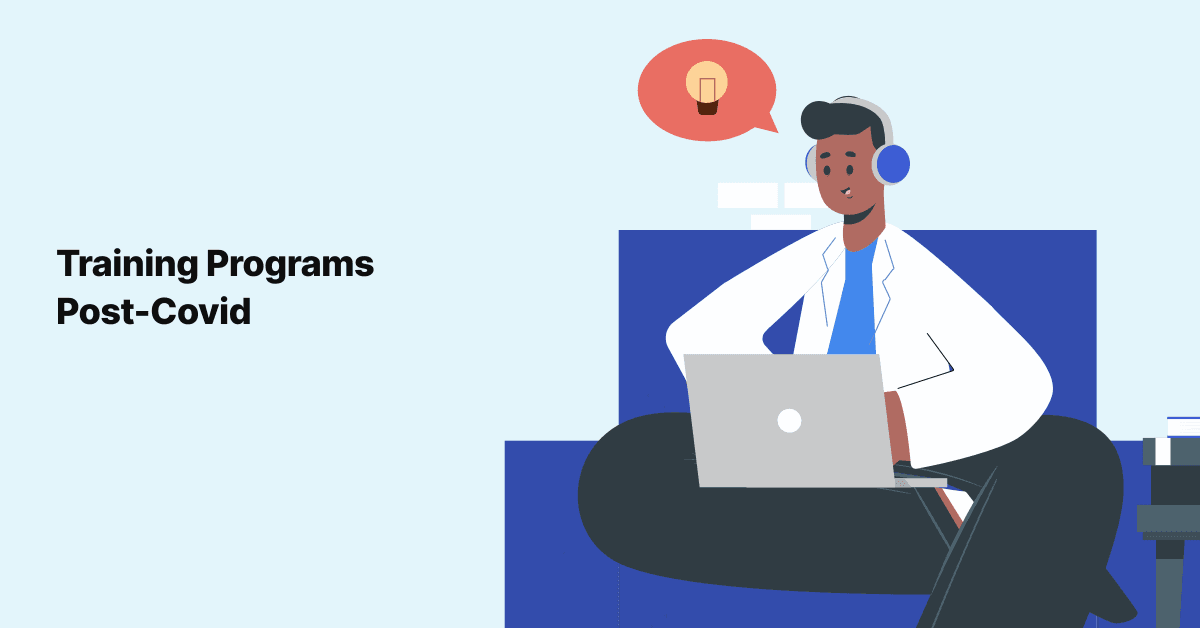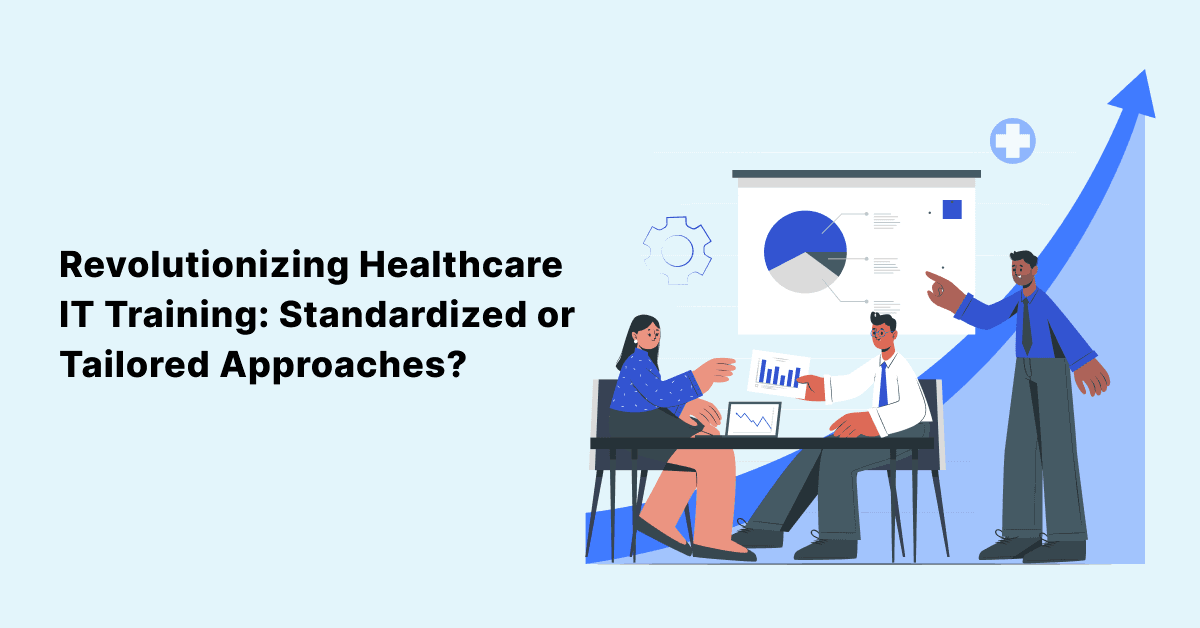
Learners are returning. Are you ready?
As you read this blog, many restrictions put in place due to Covid-19 are being relaxed. The travel …

Navigating through new software without any guidance or support can be a nightmare, right?
Now, imagine the world of healthcare IT without proper training or support. It’s a scary thought. Healthcare software training (EHR training, to be specific) and support are crucial in ensuring that physicians and nurses use the software effectively and efficiently. Whether it’s introducing new software to existing employees or managing changes to existing software, training is essential.
The real question is, should training approaches be standardized or tailored to each scenario?
In this blog, we delve into this topic, exploring effective ways to train new physicians and nurses, existing physicians and nurses on new software, and all physicians and nurses during constant software upgrades. So, keep reading!
Let’s go over what this blog covers:
Ensuring successful onboarding and training of new physicians and nurses on software can be a daunting task, especially given the varying technical expertise and learning styles. The sheer number of complex software applications to learn can lead to decreased productivity and heightened frustration. To effectively address these challenges, healthcare organizations must adopt tailored training programs that cater to the individual needs and skill levels of each physician and nurse.
To achieve this, it is imperative to move away from the traditional one-size-fits-all approach and embrace a combination of Just-in-Time and traditional training methods. Just-in-Time training is particularly effective as it provides training when a physician or nurse needs it, addressing a specific need in real time. It is also crucial to provide At-the-elbow support, enabling physicians and nurses to receive immediate assistance when required.
For instance, Donna Roach, CIO at the University of Utah Health, shared in a recent webinar with 314e and healthsystem CIO that their organization employs a multi-tiered approach. This includes providing physicians and nurses with Just-in-Time videos and in-classroom training events, both of which are tailored to the individual's learning preferences. Additionally, they offer At-the-elbow support to guide physicians and nurses through the process.
By adopting tailored training programs and providing Just-in-Time training and At-the-elbow support, healthcare organizations can ensure successful onboarding and training of new physicians and nurses on software, resulting in increased productivity and reduced frustration.
Many healthcare organizations face challenges when introducing new software applications to their existing staff. Physicians and nurses may be resistant to change and may prefer to stick with the existing software they are familiar with. This can result in a lack of interest and enthusiasm for training sessions, which can lead to a failure to effectively transfer knowledge.
However, the problem goes deeper than just a lack of interest. If physicians and nurses are not adequately trained on new software, it can lead to inefficient workflows, errors, and a reduction in the quality of patient care. The lack of enthusiasm for training may be due to a fear of change, anxiety about the learning curve, or a lack of understanding of how the new software can help them perform their tasks more efficiently.
Here are 5 tips on how to effectively train existing physicians and nurses on new software:
Are you struggling to keep your physicians and nurses up-to-date with the latest software upgrades? Do you find it challenging to balance training with their already busy schedules?
The constant evolution of software means that healthcare organizations must continually uptrain their staff to ensure they have the necessary skills to provide quality patient care. However, keeping up with these updates can be a burden, leading to stress and decreased productivity among healthcare workers.
The problem is that traditional training methods are often not effective for keeping up with constant software upgrades. Scheduling training sessions during regular working hours can disrupt healthcare workers’ schedules, leading to lost time and decreased productivity.
Furthermore, providing training materials that are too dense or difficult to comprehend can leave physicians and nurses feeling overwhelmed, which can further reduce productivity and cause burnout. The agitation comes from the fact that software upgrades are not optional and are vital for maintaining efficient patient care. Therefore, it’s essential to find a solution that addresses the problem and alleviates the agitation caused by the issue.
Here are 4 key tips on how to effectively train your physicians and nurses on constant software upgrades:
Are you looking for ways to improve the training programs for physicians and nurses in your healthcare organization?
Look no further! In a recent webinar, Alistair Erskine, Lisa Stump, and Ryan Seratt, three renowned experts in the healthcare industry, shared their insights on how to design an effective training program.
They mutually agreed upon the fact that the key to success is finding the right balance. A training program should provide enough information to be beneficial but not so much as to overwhelm learners. Each session should be tailored to what individuals can comfortably absorb in one sitting, ensuring that they can effectively retain the information and build upon it in future training sessions.
The experts emphasized that the key to success is not just providing information but also ensuring that it is absorbed by the learners. Only when physicians and nurses have truly absorbed the information presented should they move on to additional material. This approach guarantees that the training is effective and efficient, providing healthcare professionals with the knowledge and skills they need to provide exceptional patient care.
So, if you’re looking to improve your healthcare training programs, take note of this expert advice. By striking the right balance, you can equip your staff with the tools they need to succeed and improve patient outcomes.
If you wish to figure out more ways to keep your physicians and nurses trained and prepared to face changes, watch this webinar on Strategies for Keeping Users Trained Up on Ever-Changing Applications.
Experts like Alistair Erskine, Lisa Stump, and Ryan Seratt share tips on how to get past this problem with a less disruptive approach.
In conclusion, providing software training and support is crucial in healthcare settings to ensure that physicians and nurses have the necessary skills and knowledge to use the software effectively. Healthcare organizations must invest in customized training programs, e-learning platforms, and clear documentation and involve physicians and nurses in the process of software selection and changes. By doing so, organizations can ensure that physicians and nurses are equipped with the necessary skills and knowledge to use the software effectively, leading to improved patient outcomes and enhanced clinician satisfaction.
Join over 3,200 subscribers and keep up-to-date with the latest innovations & best practices in Healthcare IT.

As you read this blog, many restrictions put in place due to Covid-19 are being relaxed. The travel …

As a CIO, if you had to get your clinicians’ feedback on the newest EHR implemented or the most recent upgrade …

There is no doubt that some of the best resources available to support hospitals and health systems …